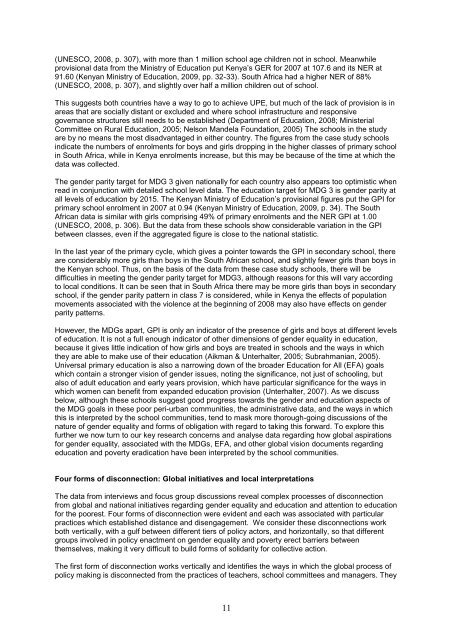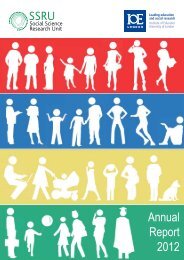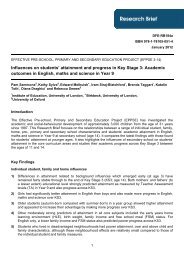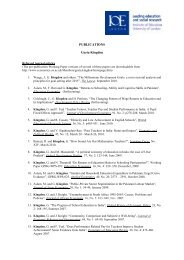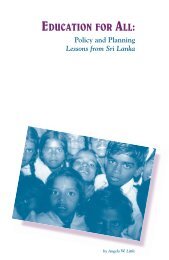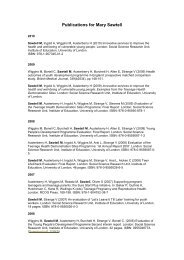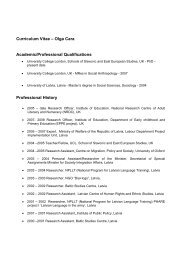Working paper 1 (pdf - Institute of Education, University of London
Working paper 1 (pdf - Institute of Education, University of London
Working paper 1 (pdf - Institute of Education, University of London
Create successful ePaper yourself
Turn your PDF publications into a flip-book with our unique Google optimized e-Paper software.
(UNESCO, 2008, p. 307), with more than 1 million school age children not in school. Meanwhile<br />
provisional data from the Ministry <strong>of</strong> <strong>Education</strong> put Kenya‟s GER for 2007 at 107.6 and its NER at<br />
91.60 (Kenyan Ministry <strong>of</strong> <strong>Education</strong>, 2009, pp. 32-33). South Africa had a higher NER <strong>of</strong> 88%<br />
(UNESCO, 2008, p. 307), and slightly over half a million children out <strong>of</strong> school.<br />
This suggests both countries have a way to go to achieve UPE, but much <strong>of</strong> the lack <strong>of</strong> provision is in<br />
areas that are socially distant or excluded and where school infrastructure and responsive<br />
governance structures still needs to be established (Department <strong>of</strong> <strong>Education</strong>, 2008; Ministerial<br />
Committee on Rural <strong>Education</strong>, 2005; Nelson Mandela Foundation, 2005) The schools in the study<br />
are by no means the most disadvantaged in either country. The figures from the case study schools<br />
indicate the numbers <strong>of</strong> enrolments for boys and girls dropping in the higher classes <strong>of</strong> primary school<br />
in South Africa, while in Kenya enrolments increase, but this may be because <strong>of</strong> the time at which the<br />
data was collected.<br />
The gender parity target for MDG 3 given nationally for each country also appears too optimistic when<br />
read in conjunction with detailed school level data. The education target for MDG 3 is gender parity at<br />
all levels <strong>of</strong> education by 2015. The Kenyan Ministry <strong>of</strong> <strong>Education</strong>‟s provisional figures put the GPI for<br />
primary school enrolment in 2007 at 0.94 (Kenyan Ministry <strong>of</strong> <strong>Education</strong>, 2009, p. 34). The South<br />
African data is similar with girls comprising 49% <strong>of</strong> primary enrolments and the NER GPI at 1.00<br />
(UNESCO, 2008, p. 306). But the data from these schools show considerable variation in the GPI<br />
between classes, even if the aggregated figure is close to the national statistic.<br />
In the last year <strong>of</strong> the primary cycle, which gives a pointer towards the GPI in secondary school, there<br />
are considerably more girls than boys in the South African school, and slightly fewer girls than boys in<br />
the Kenyan school. Thus, on the basis <strong>of</strong> the data from these case study schools, there will be<br />
difficulties in meeting the gender parity target for MDG3, although reasons for this will vary according<br />
to local conditions. It can be seen that in South Africa there may be more girls than boys in secondary<br />
school, if the gender parity pattern in class 7 is considered, while in Kenya the effects <strong>of</strong> population<br />
movements associated with the violence at the beginning <strong>of</strong> 2008 may also have effects on gender<br />
parity patterns.<br />
However, the MDGs apart, GPI is only an indicator <strong>of</strong> the presence <strong>of</strong> girls and boys at different levels<br />
<strong>of</strong> education. It is not a full enough indicator <strong>of</strong> other dimensions <strong>of</strong> gender equality in education,<br />
because it gives little indication <strong>of</strong> how girls and boys are treated in schools and the ways in which<br />
they are able to make use <strong>of</strong> their education (Aikman & Unterhalter, 2005; Subrahmanian, 2005).<br />
Universal primary education is also a narrowing down <strong>of</strong> the broader <strong>Education</strong> for All (EFA) goals<br />
which contain a stronger vision <strong>of</strong> gender issues, noting the significance, not just <strong>of</strong> schooling, but<br />
also <strong>of</strong> adult education and early years provision, which have particular significance for the ways in<br />
which women can benefit from expanded education provision (Unterhalter, 2007). As we discuss<br />
below, although these schools suggest good progress towards the gender and education aspects <strong>of</strong><br />
the MDG goals in these poor peri-urban communities, the administrative data, and the ways in which<br />
this is interpreted by the school communities, tend to mask more thorough-going discussions <strong>of</strong> the<br />
nature <strong>of</strong> gender equality and forms <strong>of</strong> obligation with regard to taking this forward. To explore this<br />
further we now turn to our key research concerns and analyse data regarding how global aspirations<br />
for gender equality, associated with the MDGs, EFA, and other global vision documents regarding<br />
education and poverty eradication have been interpreted by the school communities.<br />
Four forms <strong>of</strong> disconnection: Global initiatives and local interpretations<br />
The data from interviews and focus group discussions reveal complex processes <strong>of</strong> disconnection<br />
from global and national initiatives regarding gender equality and education and attention to education<br />
for the poorest. Four forms <strong>of</strong> disconnection were evident and each was associated with particular<br />
practices which established distance and disengagement. We consider these disconnections work<br />
both vertically, with a gulf between different tiers <strong>of</strong> policy actors, and horizontally, so that different<br />
groups involved in policy enactment on gender equality and poverty erect barriers between<br />
themselves, making it very difficult to build forms <strong>of</strong> solidarity for collective action.<br />
The first form <strong>of</strong> disconnection works vertically and identifies the ways in which the global process <strong>of</strong><br />
policy making is disconnected from the practices <strong>of</strong> teachers, school committees and managers. They<br />
11


